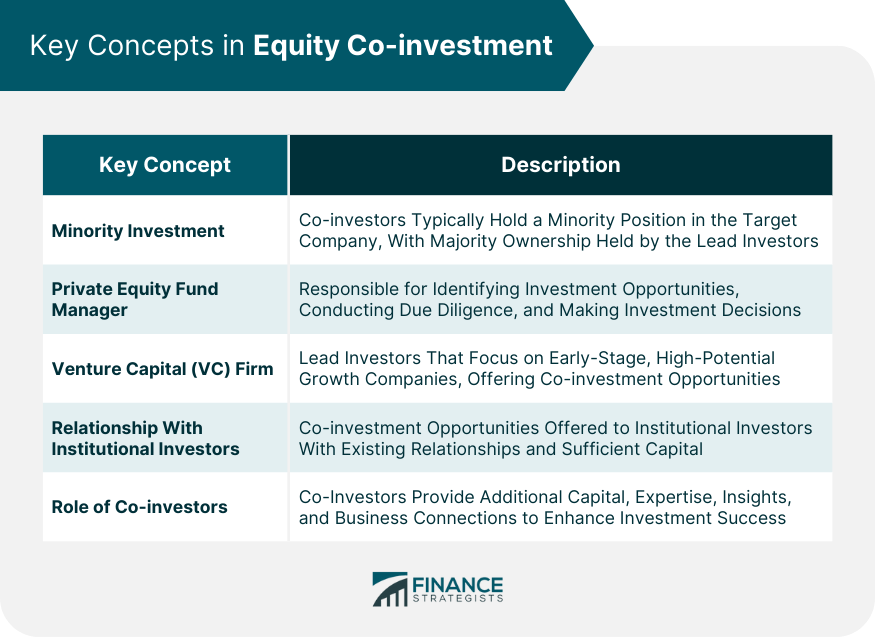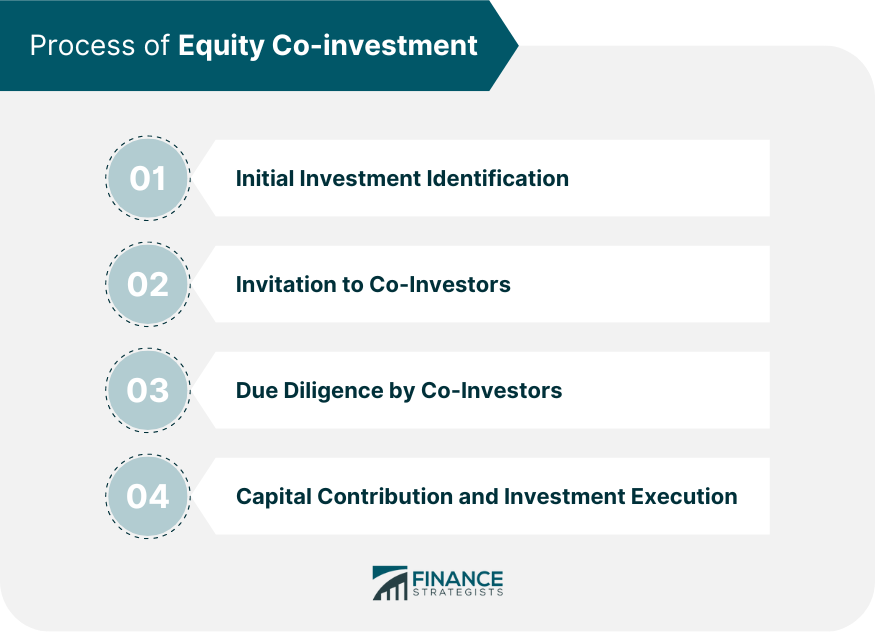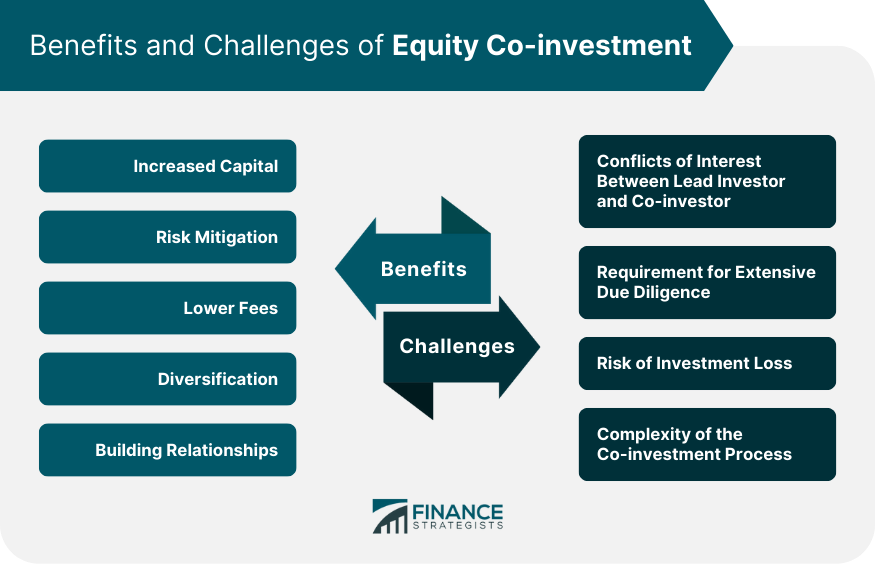Equity co-investment is a strategic form of investment in which a minority investment is made directly into an operating company alongside a private equity fund manager or a venture capital firm. These minority investors, known as co-investors, are typically large institutional investors who engage in equity co-investment to gain direct exposure to potentially high-return investments without incurring the hefty fees usually associated with private equity funds. It is important to note that co-investments are not the primary investments but are usually relatively smaller in scale and made in conjunction with larger investments by private equity or venture capital firms. The term 'equity' here refers to the ownership stake that the co-investors acquire in the target company proportional to their investment. Equity co-investment has its roots in the early days of private equity and venture capital, but it has become increasingly popular over the last two decades. Originally, these co-investments were offered as a sweetener to entice large institutional investors to participate in private equity funds. Over time, however, co-investment has emerged as a distinct and increasingly prominent feature of the private equity landscape. The financial crisis of 2008 gave a significant boost to equity co-investment as institutional investors sought ways to increase their returns while reducing their fee burden. Additionally, tightening regulations on private equity funds provided a conducive environment for equity co-investment to flourish. In equity co-investments, the co-investor typically takes a minority position in the target company. This is a key concept in equity co-investment, with the majority of the ownership typically held by the private equity fund or venture capital firm leading the investment round. The co-investor benefits from the expertise and experience of these lead investors while diversifying their portfolio and establishing a more direct connection with their investments. The private equity fund manager plays a central role in equity co-investments. They are responsible for identifying potential investment opportunities, conducting due diligence, negotiating terms, and ultimately making the investment decision. Co-investors often rely on the fund manager's expertise and market knowledge, benefiting from their diligence and negotiation power. In the context of equity co-investment, VC firms are similar to private equity fund managers in that they are often the lead investors who bring in co-investors to supplement their investments. VC firms typically focus on early-stage, high-potential growth companies, particularly in technology and innovation-driven industries. Equity co-investments provide an opportunity for co-investors to gain exposure to these high-growth potential investments that might be otherwise inaccessible. Equity co-investment opportunities are typically offered to institutional investors with whom the private equity fund manager or venture capital firm has an existing relationship. These could be pension funds, endowments, insurance companies, or family offices, among others. The reason for this exclusivity is twofold: firstly, these investors have the necessary capital to engage in co-investment; secondly, there is a level of trust and understanding between these entities, making the complex co-investment process more streamlined and efficient. Co-investors play a critical role in the equity co-investment process. They provide additional capital, allowing for larger deals and increased diversification for the private equity fund or venture capital firm. Furthermore, co-investors often bring their expertise, strategic insights, and business connections to the table, contributing to the overall success of the investment. The process of equity co-investment begins when a private equity fund or venture capital firm identifies a viable investment opportunity. This could be an upcoming startup, a company planning to scale, or even an established entity looking for further investment. The lead investor's due diligence and research capabilities play a key role in this stage as they drive the selection of potential investment opportunities. Once the lead investor determines the investment's viability and decides to proceed, they extend an invitation to trusted institutional investors to join the venture. These co-investors are generally handpicked, depending on their investment philosophy, risk tolerance, and past relationship with the lead investor. The offer is usually presented on a deal-by-deal basis, providing flexibility for co-investors to participate based on their assessment of each opportunity. Upon receiving the co-investment invitation, the potential co-investors conduct their own due diligence. This comprehensive evaluation may include assessing the company's business model, financial health, market potential, and management team. Based on their independent investigation and risk analysis, they decide whether or not to join the investment venture. If the co-investors decide to proceed, they contribute capital towards the investment, usually in a smaller proportion than the lead investor. The proportion of capital contributed depends on various factors, including the co-investors financial capacity and the agreement with the lead investor. Once the capital is pooled, the investment is executed, with the co-investors acquiring an ownership stake in the company proportional to their investment. In an equity co-investment scenario, several transaction structures can be employed. The most prevalent of these is direct equity co-investment. Here, the co-investor directly acquires a minority stake in the target company alongside the lead investor. This approach aligns the interests of all parties, facilitating collaboration and collective decision-making. Another structure is secondary co-investments, wherein the co-investor purchases an existing stake from a lead investor. This occurs when a lead investor wishes to sell part of their equity position, offering other investors the opportunity to step in. Structured equity co-investments are also common and involve more intricate investment structures like convertible debt or preferred equity. These arrangements may offer certain advantages, such as preference in dividend distribution or liquidation, thus providing an additional layer of protection for the co-investor. The increased capital allows private equity funds and VC firms to pursue larger deals that may have been out of their reach. It can also aid in diversifying the fund's investment portfolio across a wider range of companies or sectors. By inviting co-investors to share in the investment, the fund can distribute the inherent risks associated with the investment. This risk-sharing aspect can be particularly beneficial for investments in high-risk, high-reward ventures such as startups or distressed companies. Unlike traditional private equity funds that charge a management fee and a performance fee (also known as "two and twenty"), co-investments often involve reduced fees or even no fees. This lower fee structure can lead to higher net returns for the co-investor. By co-investing, institutional investors can spread their investments across multiple companies or industries, reducing their exposure to risk tied to a single investment. It also allows access to investment opportunities that they might not have been able to access independently. Finally, equity co-investment enables institutional investors to build relationships with experienced private equity and VC professionals. These relationships can lead to future co-investment opportunities and provide institutional investors with valuable industry insights and networks. Potential conflicts of interest between the lead investor and the co-investor may stem from different investment goals, timelines, risk tolerance levels, or exit strategies. For instance, a lead investor might favor a quicker exit to realize a return, while a co-investor might prefer a longer-term hold to maximize growth. Managing these conflicts requires transparent communication, aligned investment terms, and, in some cases, legal safeguards. Due diligence involves a thorough examination of the target company's financial health, market position, growth prospects, and management team, among other things. Due diligence can be a resource-intensive and time-consuming process. It requires the co-investor to have or develop significant expertise in the target industry and to understand the specific risks and rewards associated with the investment. Like any other investment, equity co-investments carry the risk of loss of investment. This risk can be exacerbated in cases where the investment is in a high-risk venture, such as a startup or a company operating in a volatile market. Co-investors must be prepared to withstand potential losses and have strategies in place to mitigate this risk. The process of equity co-investment can be complex and time-consuming. It often involves detailed negotiations with the lead investor, extensive due diligence, complex legal agreements, and ongoing monitoring of the investment. This complexity requires a significant commitment of resources from the co-investor and can present challenges, particularly for those new to co-investment. Navigating these challenges requires a clear understanding of the co-investment landscape, careful planning, and a willingness to commit the necessary resources. Despite these challenges, with the right approach and management, equity co-investment can offer significant benefits as part of a diversified investment portfolio. By spreading investments across multiple companies or sectors, co-investors can mitigate the risk tied to any single investment, providing a buffer against market volatility. By investing alongside experienced private equity funds and VC firms, co-investors can leverage the expertise of these professionals to access high-growth, high-return investments. Moreover, the reduced fee structure in co-investments can lead to higher net returns. Just like any other type of investment, equity co-investments come with inherent risks. These can include the risk of loss of investment, market risk, liquidity risk, and operational risks associated with the target company. It's crucial for co-investors to conduct thorough due diligence and risk assessment before making a co-investment. Equity co-investments can play a crucial role in achieving a balanced investment portfolio. Alongside traditional investments such as stocks and bonds, co-investments offer a unique blend of high potential returns and risk mitigation, contributing to the overall balance and health of the investment portfolio. Equity co-investments are subject to the securities regulations of the jurisdiction where they are made. These may include regulations regarding securities registration, investor qualification, disclosure requirements, and more. Regulatory compliance is crucial in co-investment to avoid legal complications and penalties. Equity co-investments involve complex legal agreements covering aspects like the structure of the investment, the rights and obligations of the co-investor, exit strategies, and more. Ensuring the legality of the investment and protecting the co-investor's rights requires careful legal planning and execution. Given the legal and regulatory complexities of co-investment, thorough compliance and due diligence are essential. Co-investors should verify the credentials of the lead investor, assess the potential legal and regulatory risks of the investment, and ensure adherence to all relevant laws and regulations. Failure to comply can result in severe legal and financial consequences. Equity co-investment is a unique investment strategy where institutional investors, alongside a private equity fund manager or venture capital firm, make a minority investment in a company. The key concepts surrounding equity co-investment involve understanding minority investment, the roles of private equity fund managers and VC firms, the relationship with institutional investors, and the roles and responsibilities of co-investors. While this strategy offers benefits such as lower fees, diversification, and the building of relationships, it also presents challenges, including potential conflicts of interest, extensive due diligence, and the risk of investment loss. Despite these, with a sound understanding of these concepts and challenges, equity co-investment can be a potent tool for portfolio diversification and potentially high returns. If you are an institutional investor considering equity co-investment, we recommend seeking professional wealth management services. Expert advice can help navigate the complex landscape of equity co-investment and enhance your investment portfolio's performance.What Is Equity Co-investment?
Origins and History of Equity Co-investment
Key Concepts in Equity Co-investment
Minority Investment
Private Equity Fund Manager
Venture Capital (VC) Firm
Relationship With Institutional Investors
Role of Co-Investors

Process of Equity Co-investment
Initial Investment Identification
Invitation to Co-Investors
Due Diligence by Co-Investors
Capital Contribution and Investment Execution

Exploring Equity Co-investment Transaction Structures
Direct Equity Co-investment
Secondary Co-investments
Structured Equity Co-investments
Benefits of Equity Co-investment
Benefits for Private Equity Funds and VC Firms
Increased Capital
Risk Mitigation
Benefits for Co-investors
Lower Fees
Diversification
Building Relationships
Challenges and Risks of Equity Co-investment
Conflicts of Interest Between Lead Investor and Co-Investor
Requirement for Extensive Due Diligence
Risk of Investment Loss
Complexity of the Co-investment Process

Role of Equity Co-investment in a Portfolio
Diversification
Potential Returns
Risks
Role in a Balanced Investment Portfolio
Regulatory and Legal Landscape of Equity Co-investment
Regulatory Concerns
Legal Implications
Compliance and Due Diligence
Final Thoughts
Equity Co-investment FAQs
Equity co-investment is a minority investment made by investors alongside a private equity fund manager or venture capital firm in a company.
Equity co-investments typically involve private equity funds or venture capital firms as the lead investor, with institutional investors acting as co-investors.
Benefits of equity co-investment include lower fees, portfolio diversification, and the opportunity to build relationships with experienced private equity and venture capital professionals.
Challenges of equity co-investment include potential conflicts of interest between the lead investor and the co-investor, the need for extensive due diligence, and the risk of investment loss.
Equity co-investment can enhance portfolio diversification, provide potentially high returns, and contribute to achieving a balanced investment portfolio.
True Tamplin is a published author, public speaker, CEO of UpDigital, and founder of Finance Strategists.
True is a Certified Educator in Personal Finance (CEPF®), author of The Handy Financial Ratios Guide, a member of the Society for Advancing Business Editing and Writing, contributes to his financial education site, Finance Strategists, and has spoken to various financial communities such as the CFA Institute, as well as university students like his Alma mater, Biola University, where he received a bachelor of science in business and data analytics.
To learn more about True, visit his personal website or view his author profiles on Amazon, Nasdaq and Forbes.











